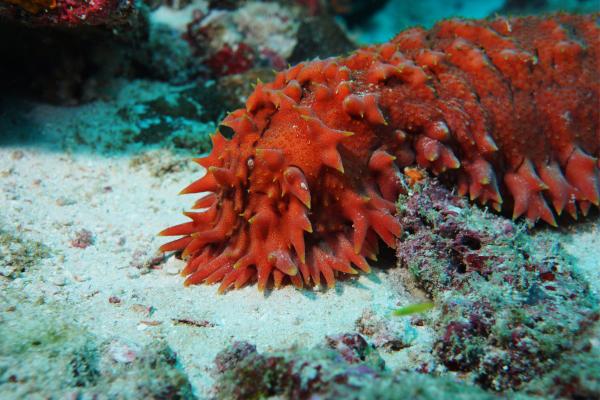Sea cucumbers are marine invertebrates, specifically echinoderms, belonging to the class Holothuroidea. Their characteristics include a robust, worm-like appearance, exposed tentacles, and tube feet surrounding their bodies. Reproduction varies greatly between species and can be sexual or asexual, with egg laying or egg retention.

The seas are home to animals that are very strange to us and unfamiliar to us. Among them are aquarium/sea-cucumbers.html">sea cucumbers, which are very similar to starfish. Although they look nothing alike on the outside, they actually share many characteristics in common. As their common name suggests, they have an elongated and robust shape. In some countries, they are commonly consumed as food, although their value is not only commercial as food; they also have important ecological value as scavengers of the seabed.
Sea cucumbers are invertebrate aquarium/52-marine-animals.html">marine animals . They are related to starfish, as they belong to the same phylum, echinoderms (Echinodermata). You can learn more about them here : Echinoderms: what they are, characteristics, classification, and examples .
Domain: Eukaryota
Kingdom: Animalia
Superphylum: Deuterostomia
Phylum: Echinodermata
Subphylum: Eleutherozoa
Class: Holothuroidea
Thanks to the name of the class to which they belong, they can also be found under the name of holothuroids or holothurians.
There are nearly 1,000 different species of sea cucumbers. Here are some of them:
Cucumaria frondosa (orange-footed sea cucumber)
Apostichopus japonicus
Isostichopus badionotus
Holothuria scabra
Astichopus multifidus
Holothuria floridana
Astichopus multifidus
Benthodytes sanguinolenta
Cucumaria minata
Enypniastes eximia
You might be interested in discovering these interesting facts about invertebrate animals , such as sea cucumbers.

Sea cucumbers are worm-like but very robust animals . They lack faces and limbs. Their consistency is soft.
They don't have a skeleton, but instead have skeletal elements called ossicles beneath the epidermis. These are very small and microscopic, embedded throughout the dermis. They come in various shapes and are helpful in species identification.
They measure approximately 20 centimeters, but there are sizes from 1 to 30 centimeters .
They have a cosmopolitan distribution throughout the oceans , found on the seafloor and at a wide range of depths, from the intertidal zone to 5,000 meters. You can learn more about cosmopolitan species here: what they are and examples .
They have highly developed musculature that serves their unique purpose of locomotion. They are generally sedentary or slow-moving , merely crawling, although some are capable of swimming with their corresponding fin-like extensions. All have tube feet arranged in five rows, reflecting the pentamerous characteristics of echinoderms. In addition to these feet' functions, they also play a role in gas exchange.
They have characteristic external oral tentacles , the number of which varies from species to species. They surround the pharynx and extend beyond the mouth. Their shape also varies, and they can be pinnate, dendroid, digitate, or peltate, adapted to their particular feeding habits. These tentacles attach to a calcareous ring located in the anterior part of the esophagus.
Since they belong to echinoderms, they have pentaradial symmetry , but only on the inside, as seen in the organs. Externally, the symmetry is bilateral .
Some cucumbers, when threatened, expel tubercles lodged in their anus, intended to ward off predators. These structures are called Cuvierian tubules .
Many species breathe from the cloacal opening, from which so-called respiratory trees extend .
Feeding habits are very broad within this class. They generally feed on organic matter , which is why they are classified as scavengers , although they also consume plankton , microscopic benthic algae, and small animals that live on the seabed, which may be polychaetes , amphipods , gastropods , or other invertebrates. To feed, they expose their tentacles to water currents or within the seabed, and trap small particles in the water.

Reproduction in sea cucumbers varies greatly from species to species. They typically have separate sexes , although some species are protandrous hermaphrodites , meaning an organism alternates sexes. You can read more about hermaphroditic animals: reproduction and examples here .
Fertilization is usually external, with males and females releasing their gametes into the water to await fertilization. Some species exhibit viviparity, with internal fertilization . The result of this sexual reproduction is an egg, from which a larva called auricularia emerges, followed by the dolioaria larva, and ending with the pentacularia larva. In this succession of larvae, the morphology becomes increasingly complex until the adult is finally formed.
There are also some species that do not follow this sexual route, but rather reproduce by binary fission or bipartition , an asexual process regulated by the nervous system in which the cells of an organism divide to result in two organisms with the same genetic information. For sea cucumbers, this occurs at the anterior and posterior ends, that is, in front and behind. This type of reproduction is not as common and is still being studied, but it has already been proven that 16 species definitely have the capacity for binary fission. In this other article you can read about Asexual Reproduction: What It Is, Types, and Examples .
Now that you have learned much more about what sea cucumbers are, their characteristics and reproduction, we encourage you to read about other amazing marine animals such as the Sea Rabbit: what it is, characteristics and reproduction and the Sea Dragon: what it is and characteristics .
Dolmatov, I. Y. (2014). Asexual reproduction in holothurians. The Scientific World Journal, 2014.
Slatter, M. & Chen. J. (2015). Echinoderm Aquaculture . United Kingdom: Wiley.
Zetina, C., Ríos, G., Hernández, I., Guevara, M., Ortiz, E., Pool, J. (2002) Catalogue of marketable sea cucumber species from the state of Yucatán (series). Mexico: Autonomous University of Yucatán Publishing House.
animal tags: Sea cucumber
We created this article in conjunction with AI technology, then made sure it was fact-checked and edited by a Animals Top editor.